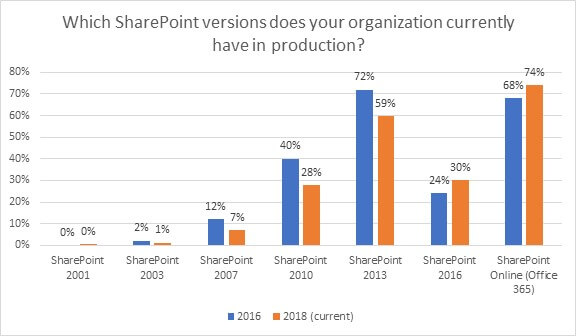 It’s been over 5 years since SharePoint 2013 was released, almost around the same time Rencore was founded in fact. Five years is a long time in IT, so we have put together five things you should consider when running SharePoint 2013 or planning an upgrade.
It’s been over 5 years since SharePoint 2013 was released, almost around the same time Rencore was founded in fact. Five years is a long time in IT, so we have put together five things you should consider when running SharePoint 2013 or planning an upgrade.
1. SharePoint 2013 Usage
It’s not surprising to learn that SharePoint 2013 is decreasing in usage as newer updates are released. Our data shows a 13% drop in users since 2016. However, it is still a popular SharePoint platform with 58% of organizations opting for its services, and only SharePoint Online and Office 365 outperform it with 74% usage. One thing’s for certain though, Microsoft’s cloud collaboration platform is gaining traction, so how long will you be able to resist the inevitable shift? Maybe, a partial or full migration project is on the horizon for your organization.
2. Deprecating support for SharePoint 2013
Just in case you needed to hear it from the ‘horse’s mouth’, Microsoft announced that mainstream support for SharePoint 2013 ended on April 10th, 2018. From this date, only security fixes are provided for SharePoint 2013. Regular hot fixes can no longer be requested. If not already done so, we recommend to start planning a migration to SharePoint Server 2016 as soon as possible. We recommend our following blog: Deprecating Features in SharePoint – Are you Prepared? for more info about if or when deprecating features could affect your SharePoint environment and how to learn about them in good time.
3. 75% of farm solutions in SharePoint 2013 have memory leaks
Memory leaks are something a lot of companies have to deal with when running SharePoint, and in particular, SharePoint 2013 full trust farm solutions. Many SharePoint server-side API’s rely on COM objects which are not managed by the .NET garbage collector. So, if you don’t dispose of certain objects – like SPWeb and SPSite – you’ll run the risk of encountering some memory leaks.
In turn, this will have a huge impact on your SharePoint farm. If a piece of affected code is executed frequently (let’s say on the intranet landing page), memory usage of the w3wp.exe process of the Internet Information Server (IIS), used by SharePoint, can increase rapidly. When the server(s) inevitably run out of memory, IIS will recycle the application pool.
This can result in a loss of information, temporary time-outs, and generally an unstable platform. This has been a common issue since its release in 2013 and we produced a blog article around that time explaining how you can solve this problem. Please check out this early blog titled “STOP using SPDisposeCheck (or MSOCAF) with SharePoint 2013! Now!” For further information on this topic.
4. Limited but not ‘Zero’ downtime
Microsoft understands the inconvenience of SharePoint downtime and concedes, that however minimal, a SharePoint farm does need downtime to update (a patch is available for SharePoint 2016). This means organizations may need to try and run updates out of business hours, but for many organizations, SharePoint is used across multiple time zones, so inevitably some disruption will be caused if you are running SharePoint 2013. SharePoint Online does not require downtime due to the very nature of the platform being a Software as a Service (SaaS) – maybe it’s worth checking in with our migration expert MVP, MCM, and MCSM Erwin van Hunen to find out the best migration practices to the cloud.
5. Maintain the health of your SharePoint 2013 platform
Luckily for all SharePoint users, our SharePoint Code Analysis Framework (SPCAF) is the only tool that supports disposal checks, all round code quality, performance and security analysis in SharePoint 2013 (and all other versions of SharePoint). Besides memory leak analysis, the tool will do so much more: code analysis, possible upgrade issues, compliancy verification, compatibility checks for a certain SharePoint version etc.




